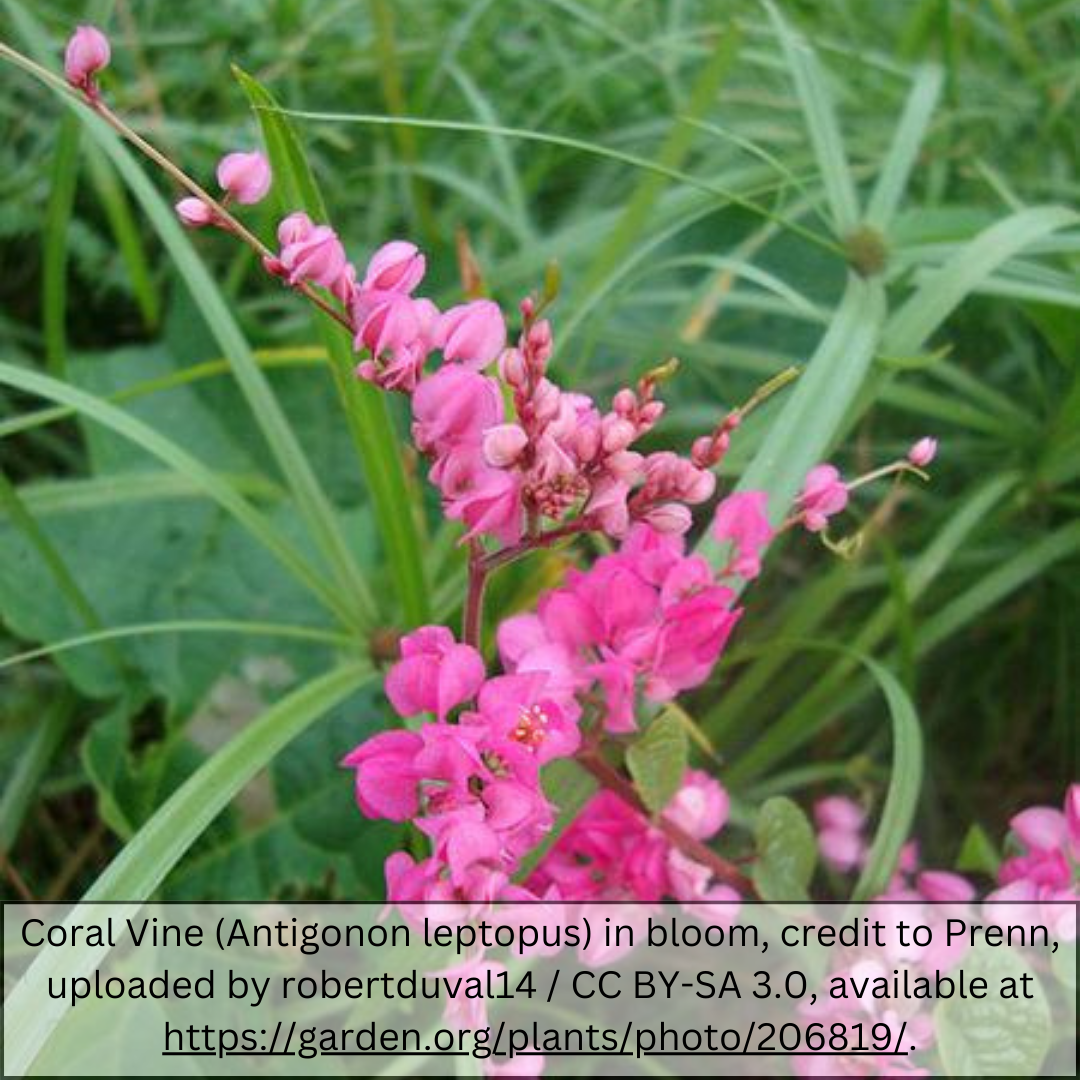My Store
Queen's Wreath 'Pink'
Queen's Wreath 'Pink'
Couldn't load pickup availability
Plant Type: perennial vine
Plant Height: 15–30 feet (with support)
Spread: 6–10 feet
Flower Color: pink
Sun Exposure: Full sun, Partial Shade
Queen’s Wreath (Antigonon leptopus): Cascading Tropical Color for Walls and Trellises
Queen’s Wreath, also known as Coral Vine or Mexican Creeper, is a fast-growing, flowering vine with stunning pink blossoms that cascade like a waterfall over fences, trellises, or arbors. It’s a beloved warm-season bloomer that thrives in Arizona’s heat, bringing soft tropical beauty and pollinator appeal to sunny outdoor spaces.
Key Features of Queen’s Wreath
- Vibrant Pink Blooms: Masses of bright pink, heart-shaped flowers appear from late spring through fall, often blooming nonstop during the warm months.
- Climbing Habit: Rapidly climbs with tendrils, ideal for fences, pergolas, mailboxes, or bare walls.
- Heat-Loving: Thrives in hot, dry climates with minimal care once established.
- Pollinator Favorite: A magnet for bees and butterflies, making it perfect for pollinator gardens and eco-friendly landscapes.
Growing and Care Tips
Queen’s Wreath is a tropical-looking vine with surprisingly tough roots and low water needs once established.
Soil: Prefers well-drained soil and tolerates sandy or rocky ground. Amend clay to improve drainage.
Water: Requires regular deep watering during establishment. Once mature, it performs well with occasional irrigation.
Fertilizer: Apply a balanced fertilizer in early spring to support vigorous growth and heavy blooming.
Pruning: Cut back in late winter to control size and promote new flowering vines. It may die back after frost but will return from the roots.
Landscaping Uses
- Trellises and Arbors: Perfect for softening garden structures or adding seasonal color overhead.
- Privacy Screens: Covers chain-link or unsightly fences quickly with lush greenery and flowers.
- Walls and Mailboxes: Climbs brick, wrought iron, and wooden supports easily for vertical color.
- Container Planting: Can be grown in large pots with a trellis or tower for small patios.
Summary
Queen’s Wreath brings lush, trailing beauty to desert gardens. With vivid blooms, fast growth, and heat resilience, it’s one of the best vines for Arizona landscapes looking to add softness, color, and vertical interest all season long.
Three Timbers Installation Guide (Feel Free to Follow): Queen’s Wreath
Planting Guide:
Location: Full sun preferred for maximum blooms. Tolerates partial shade but may flower less profusely.
Soil: Well-drained soil is essential. Avoid low-lying areas that hold water.
Spacing: Space 6–10 feet apart if planting multiples; give room to sprawl or climb.
Planting Depth: Plant root crown level with the soil surface. Avoid burying the crown or base of the stems.
Support: Requires a trellis, arbor, fence, or wall to climb. Secure with garden ties as needed until established.
Watering Guide:
Watering After Planting:
- Initial Watering: Water deeply at time of planting.
- Frequency: Water every 2–3 days for the first 2–3 weeks.
- Watering Amount: Apply 1–2 inches of water per session to soak the root zone.
When is the Plant Established?
- Queen’s Wreath is considered established after 2–3 months of regular watering and new vine growth.
Watering Once Established:
- Summer: Water every 7–10 days in extreme heat or during dry spells.
- Winter: Water every 4–6 weeks if there is little to no rainfall.
Drip Irrigation Setup:
Placement of Emitters: Place one emitter 12–18 inches from the plant base, near the root ball.
Flow Rate: Use a 1–2 gallon-per-hour emitter for steady moisture.
Number of Emitters: Start with 1; add a second as the root system expands.
Adjusting Frequency: In summer, water every 7–10 days. In winter, reduce to every 4–6 weeks based on soil dryness.
General Watering Tips for Queen’s Wreath:
- Soil Check: Allow top 2–3 inches to dry between watering. Avoid constantly wet soil.
- Avoid Overwatering: Roots are sensitive to soggy soil—ensure proper drainage.
- Mulch: Apply a thin gravel or bark mulch around the base to reduce evaporation, but leave space around the main stem to prevent rot.
Share














